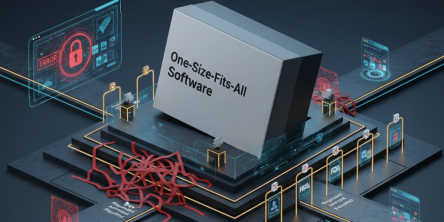Application Integration vs. Data Integration: Purpose, Pros, Cons & Everything in Between

Businesses need to plan and prepare before digitizing operations to survive and thrive in a dynamic business environment. If you want to get things right from the start, it is essential to know the basics of integration technologies.
What is Application Integration?
Application integration is the fusion of information and workflows from different apps. Digitization of operations exerts a compelling need for companies to integrate cloud and on-premise apps. App integration facilitates seamless interoperability and orchestration of data for generating real-time insights.
What is Data Integration?
It is the approach of retrieving data from varied sources and collating it to create a unified layout. Data integration solves the complications of merging different apps to stay on top of data assets. It enables users to extract value from the integrated interface.
Data integration can be further classified into two categories - Operational and Analytic
Analytic DI is applied to business intelligence and data warehousing. Operational DI is ideal for synchronization, consolidation & migration of active databases. It also facilitates data exchange in a business-to-business situation.
In simple terms, DI is the mechanism for merging data between databases, and app integration is for handling data between applications.
3 Key Differences Between AI and DI
1. Efficiency vs. Effectiveness:
Data integration is a scheduled, batch mode procedure that attends to the data at rest. It is why it calls for a sequence of data-intensive approaches. It involves standardization, manipulation, duplication, and reconciliation of data in batches. A data integration task can be run once in a day or a week. However, it cannot be run several times in one instance to get accurate insights into business performance. It also takes a considerable amount of computing time to generate compliance data and identify anomalies.
App integration facilitates real-time communication of live data between apps. The information only changes hands between different apps, following a two-directional orientation. The amount of time taken and data involved in enterprise application integration is modest. It deals with different app connections at the workflow level, with information being the focal point of transference.
2. Transferable vs. Transformative:
App integration works at a service level framework for the timely movement of data. This data flows between applications through an execution process that may be synchronous or asynchronous. In short, enterprise application integration facilitates business operations that traverse across independent applications. These processes are transactional and entail a level of abstraction between the allied business operations and basal applications.
As opposed to this, data integration is a transformative process. It stems from the deployment of relevant databases and the need to transfer data between them. The main goal of data integration is to colonize a warehouse from different transactional mechanisms. The data is extracted from databases and collated to form a unified system of the collated information for analysis. Data integration creates a layer of abstraction from the rudimentary sources. It also includes extrinsic data that lies within the sphere.
3. Clear-cut vs. Consolidated:
Enterprise application integration runs in a predefined architecture. This approach is adopted to synchronize the associated apps in real-time. It also facilitates the maintenance of integration until the end of the procedure. For instance, in a P2P business process, a company procures raw materials from vendors. This process starts with the issuance of requisition orders for purchasing raw materials. It further proceeds to the next stage where a purchase order is created. On the receipt of goods, the documents for order confirmation and shipping notice are framed. Finally, an invoice is generated for the payment and the transaction is updated in the accounting system. This complex process spans across several application systems and external sources. As a Procure to Pay business process may involve outsourcing, the events need to be executed in sequential order. It creates interdependence due to which there is stringent opposition to overlapping. And, it is where the clear-cut architecture of enterprise application integration emerges as an ideal solution.
Data integration runs through the data cluster from end-to-end but publishes only relevant data to the user. Large organizations have scores of integrated applications. It makes access to difficult independent interfaces. Data integration is helpful in such cases for quick and easy data access.
Conclusion
If you're still wondering which approach to take, it's essential to know that each is a perfect fit for a different purpose. Data integration combines data sets from various sources—app integration, on the other hand, converts and shares data between applications.
Accordingly, enterprise application integration is ideal for working with data at the application levels. And, data integration is perfect if your business is operating at the database level.
Similar Articles
It is neither secret nor news that the mind-boggling pace of digital transformation around us has totally altered consumer expectations.
In the world of finance, speed and accuracy are everything. Decisions made a day late can cost millions, and delayed visibility into financial performance can leave even the best organizations blind to risks.
Discover the best tools to enhance employee recognition, boost morale, and create a more motivated, engaged workplace culture.
At first glance, off-the-shelf software appears to be a dream come true. They are quick to set up, cheaper upfront, and marketed as “universal.”
A modern business must continually adapt. This bit everyone seems to know.
The modern healthcare industry is undergoing a significant transformation. The models of healthcare that we are used to thus far are now making way for a more data driven approach
In the modern world, maintaining good health often feels like a constant challenge. Between busy lifestyles, sedentary habits, and lack of motivation, many people find it difficult to stay consistent with exercise, diet, or wellness practices.
Every news publisher's dream, or just getting started, hits that wall sooner or later. What do you build your site on? You’ve basically got two roads: WordPress or custom development.
Discover key features construction teams need in permit tracking software to boost efficiency, stay compliant, and streamline project management.








